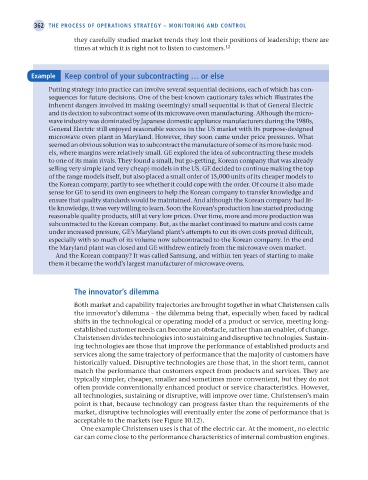Page 387 - Operations Strategy
P. 387
362 The proCess oF operaTIons sTraTegy – monITorIng and ConTrol
they carefully studied market trends they lost their positions of leadership; there are
times at which it is right not to listen to customers. 12
example Keep control of your subcontracting … or else
Putting strategy into practice can involve several sequential decisions, each of which has con-
sequences for future decisions. One of the best-known cautionary tales which illustrates the
inherent dangers involved in making (seemingly) small sequential is that of General Electric
and its decision to subcontract some of its microwave oven manufacturing. Although the micro-
wave industry was dominated by Japanese domestic appliance manufacturers during the 1980s,
General Electric still enjoyed reasonable success in the US market with its purpose-designed
microwave oven plant in Maryland. However, they soon came under price pressures. What
seemed an obvious solution was to subcontract the manufacture of some of its more basic mod-
els, where margins were relatively small. GE explored the idea of subcontracting these models
to one of its main rivals. They found a small, but go-getting, Korean company that was already
selling very simple (and very cheap) models in the US. GE decided to continue making the top
of the range models itself, but also placed a small order of 15,000 units of its cheaper models to
the Korean company, partly to see whether it could cope with the order. Of course it also made
sense for GE to send its own engineers to help the Korean company to transfer knowledge and
ensure that quality standards would be maintained. And although the Korean company had lit-
tle knowledge, it was very willing to learn. Soon the Korean’s production line started producing
reasonable quality products, still at very low prices. Over time, more and more production was
subcontracted to the Korean company. But, as the market continued to mature and costs came
under increased pressure, GE’s Maryland plant’s attempts to cut its own costs proved difficult,
especially with so much of its volume now subcontracted to the Korean company. In the end
the Maryland plant was closed and GE withdrew entirely from the microwave oven market.
And the Korean company? It was called Samsung, and within ten years of starting to make
them it became the world’s largest manufacturer of microwave ovens.
The innovator’s dilemma
Both market and capability trajectories are brought together in what Christensen calls
the innovator’s dilemma – the dilemma being that, especially when faced by radical
shifts in the technological or operating model of a product or service, meeting long-
established customer needs can become an obstacle, rather than an enabler, of change.
Christensen divides technologies into sustaining and disruptive technologies. Sustain-
ing technologies are those that improve the performance of established products and
services along the same trajectory of performance that the majority of customers have
historically valued. Disruptive technologies are those that, in the short term, cannot
match the performance that customers expect from products and services. They are
typically simpler, cheaper, smaller and sometimes more convenient, but they do not
often provide conventionally enhanced product or service characteristics. However,
all technologies, sustaining or disruptive, will improve over time. Christensen’s main
point is that, because technology can progress faster than the requirements of the
market, disruptive technologies will eventually enter the zone of performance that is
acceptable to the markets (see Figure 10.12).
One example Christensen uses is that of the electric car. At the moment, no electric
car can come close to the performance characteristics of internal combustion engines.
M10 Operations Strategy 62492.indd 362 02/03/2017 13:28

